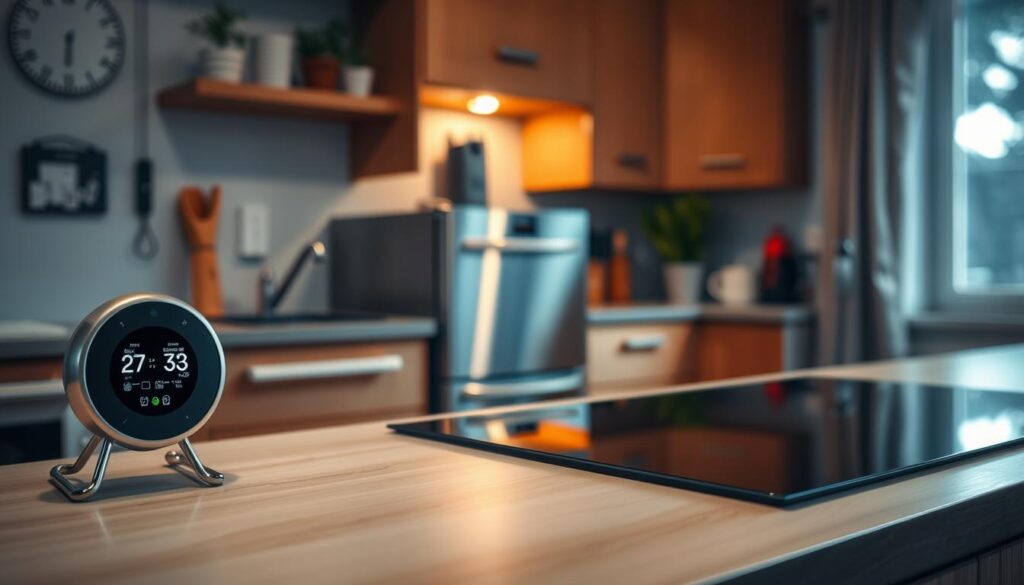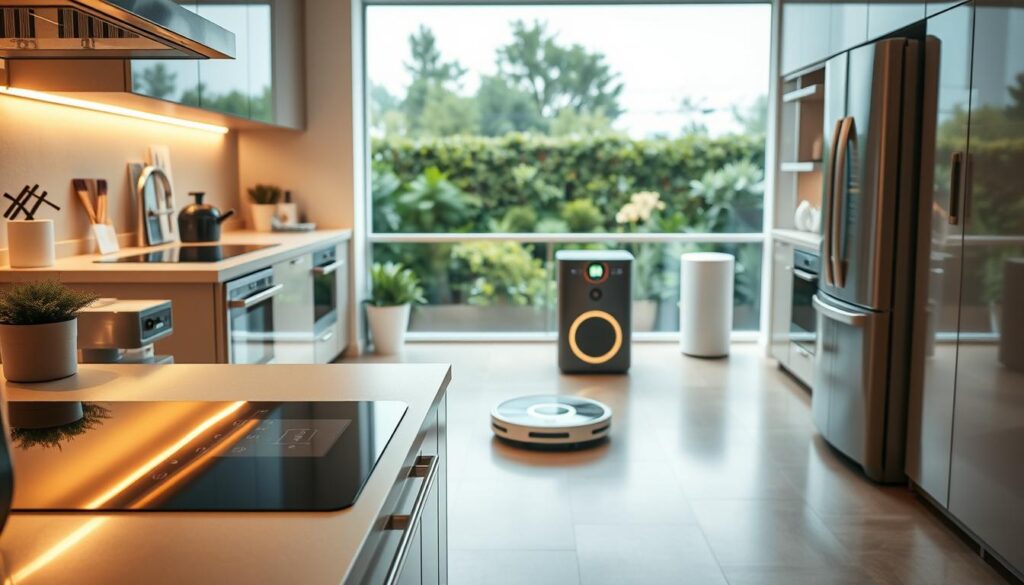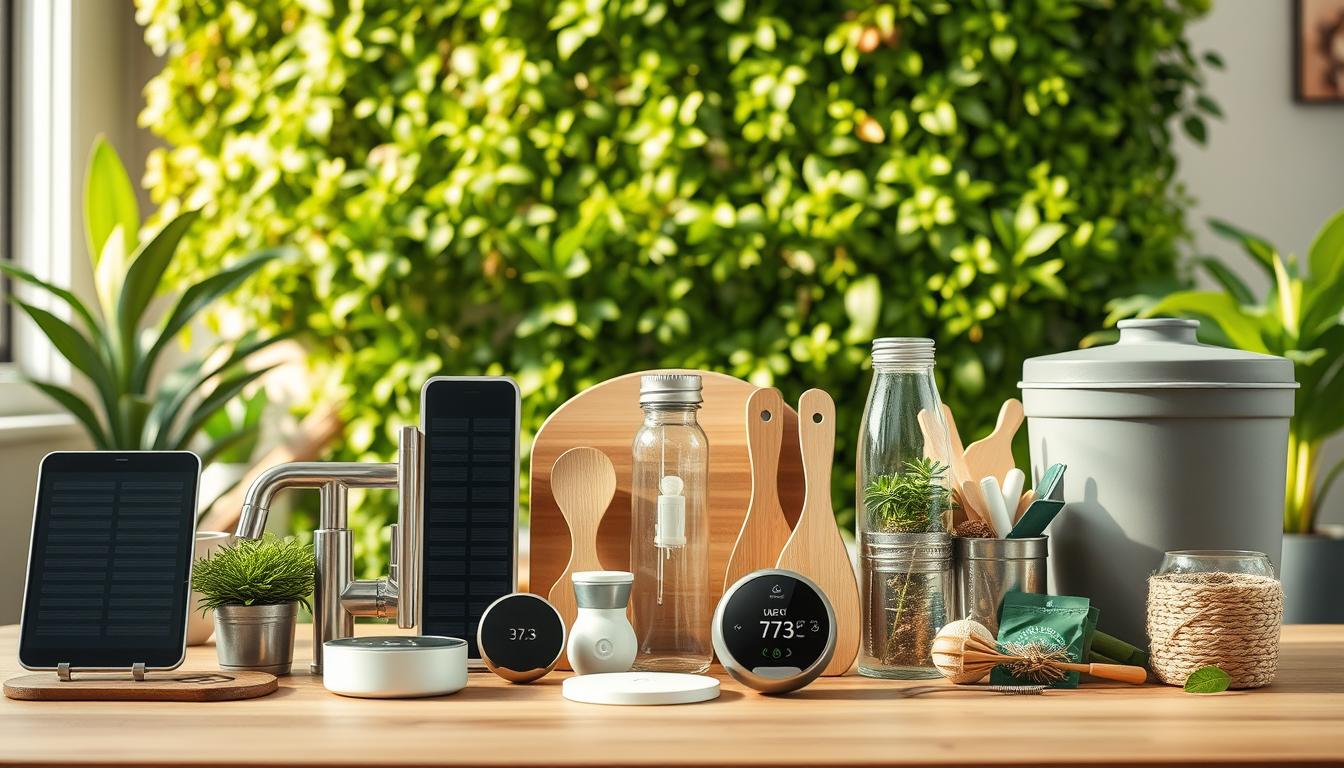Turning your home into an eco-friendly space doesn’t mean sacrificing modern comfort. Eco-friendly gadgets for home offer practical solutions to reduce waste, save energy, and align daily life with sustainability. From smart thermostats to solar chargers, these innovations make it easier than ever to shrink your environmental footprint without complicating routines.
Every small change counts. This guide highlights 12 must-try devices that merge cutting-edge tech with planet-first principles. Whether you’re upgrading appliances or exploring smart home systems, these tools prove sustainability can be both accessible and stylish.
Key Takeaways
- Eco-friendly gadgets for home simplify reducing energy use and waste.
- Modern tech like smart plugs and reusable bottle systems fit seamlessly into daily life.
- Investing in green devices supports long-term cost savings and environmental health.
- These tools empower homeowners to track and lower their carbon footprint effectively.
- Innovations like solar-powered chargers and compost bins make sustainability achievable for all.
Introduction to Sustainable Living and Modern Home Gadgets
More households today are adopting eco-friendly practices to reduce their environmental footprint. Sustainable living gadgets now play a vital role in making this shift accessible and practical. These innovations blend technology with environmental responsibility, offering solutions for everyday challenges.
The Shift Towards Eco-conscious Living
Rising awareness of climate change and resource scarcity drives people to choose products that align with their values. Brands like Philips and EcoFlow lead this movement, designing appliances that cut energy use and waste. From solar-powered chargers to smart water monitors, these tools simplify adopting greener habits without sacrificing convenience.
Key Benefits of Green Home Technology
- Energy savings: Devices like Nest thermostats lower utility bills by optimizing heating/cooling use.
- Health improvements: Air purifiers from brands like Coway filter toxins, enhancing indoor air quality.
- Cost efficiency: Long-lasting LED bulbs from Cree reduce frequent replacements and waste.
These gadgets also streamline routines—smart sensors automate light and water usage, saving time while protecting resources. Every choice contributes to a cycle of sustainability that benefits both homes and the planet.
Exploring Eco-friendly gadgets for home
When it comes to making your home greener, there’s a gadget for every room and task. Modern green home appliances blend innovation with simplicity, helping families reduce waste and save resources. Let’s look at top picks that make sustainability effortless.
- Smart thermostats: Brands like Nest and Ecobee adjust heating/cooling based on occupancy, cutting energy use by up to 20%.
- Water-saving showerheads: Products from Waterpebble or Brondell reduce water flow without sacrificing pressure, slashing monthly bills.
- Solar-powered chargers: Brands like Anker offer portable solutions, harnessing sunlight to power phones and tablets.
| Gadget | Brand | Key Feature | Price Range |
|---|---|---|---|
| Smart Thermostat | Nest Learning Thermostat | AI-driven energy management | $150–$250 |
| Water-Saving Showerhead | Waterpebble | Cuts water use by 40% | $30–$50 |
| Solar Charger | Anker PowerPort Solar | Fast charging under sunlight | $80–$120 |
“Our EcoBee thermostat saved us $300 last year on heating alone.” – Sarah T., California homeowner
Many green home appliances qualify for tax rebates, making upgrades even smarter financially. These tools aren’t just eco-friendly—they’re designed for ease. Whether you’re upgrading a kitchen or bathroom, there’s a gadget to match your goals.
Innovative Sustainable Living Gadgets for Everyday Use
Turning eco-conscious goals into daily habits starts with the right tools. Environmentally friendly home devices are designed to simplify sustainability without disrupting routines. Let’s explore how these gadgets fit into your life.
Usage in Daily Routines
Imagine charging your phone with a solar-powered dock while sipping tea from a reusable bamboo mug. Environmentally friendly home devices like the EcoCharge Solar Panel or the ZeroWaste Kitchen Scale make eco-friendly choices automatic. Here’s how:
- Smart sprinkler systems track weather data to water lawns efficiently
- LED bulbs with motion sensors cut energy use by 70%
- Compost bins with odor-blocking tech encourage kitchen waste recycling
Environmental Impact
These devices create measurable change. A 2023 study by the Green Tech Institute found that households using environmentally friendly home devices reduced their carbon footprint by 25% annually. Take the EcoClean Air Purifier—its HEPA filters remove 99% of pollutants while using 40% less electricity than standard models.
“My water-saving showerhead cut our monthly bills and conserved 1,200 gallons yearly. It’s a no-brainer.” – Sarah M., eco-tech user since 2022
User-friendly Design
Modern environmentally friendly home devices prioritize simplicity. The Nest Learning Thermostat learns your schedule to adjust heating/cooling automatically, saving energy without manual effort. Even kids can operate the Lomi Composter, which turns food scraps into soil in 24 hours with a touchscreen interface.
From sleek solar-powered clocks to voice-activated recycling bins, these gadgets prove sustainability doesn’t mean complexity. They’re built for real life, not labs.
Energy-Efficient Home Gadgets and Green Appliances
Modern energy-efficient home gadgets are transforming how households reduce energy waste. From smart thermostats to solar-powered chargers, these tools blend innovation with sustainability. They cut electricity use without sacrificing comfort, making eco-friendly living accessible.

- Smart Lighting: Philips Hue bulbs use 80% less energy than incandescent options.
- Appliance Upgrades: LG’s ThinQ refrigerators adjust cooling based on usage patterns.
- Heating Solutions: Nest Learning Thermostats learn routines to save 10-12% on heating bills annually.
“Switching to energy-efficient devices can reduce a home’s carbon footprint by up to 30% within a year.” – Dr. Emily Carter, Sustainable Tech Institute
These appliances often qualify for government rebates, making the transition budget-friendly. For example, EcoFlow’s portable solar generators let you power devices off-grid while cutting utility costs. Many models come with real-time energy monitors, showing users exactly where they’re saving. Small changes, like replacing old appliances with ENERGY STAR-certified ones, add up to big environmental wins. Start with one gadget today—your wallet and the planet will thank you!
Smart Home Devices: Merging Convenience with Eco-consciousness
Smart home tech is reshaping how we balance comfort and sustainability. Voice-controlled devices simplify everyday tasks while reducing energy waste. Imagine adjusting lighting or heating with a simple command—this hands-free control makes eco-friendly choices effortless.
Voice-controlled Smart Gadgets
Systems like Amazon Echo and Google Nest Hub let users manage energy use through voice commands. These eco-conscious household tools link to smart bulbs or plugs, ensuring lights turn off automatically when rooms are empty.
Automation for Energy Savings
Automation isn’t just convenient—it’s a game-changer for reducing carbon footprints. Smart thermostats like Ecobee or Nest learn routines, adjusting temperatures when no one’s home. A 2023 study by the US Department of Energy found such devices cut HVAC energy use by up to 20%.
| Device | Feature | Eco-Benefit |
|---|---|---|
| Philips Hue Lights | Schedule-based dimming | Cuts electricity use by 60% |
| August Smart Lock | Remote monitoring | Reduces unnecessary entry/exit energy spikes |
Integrating Green Technology
Pairing devices into a unified system amplifies their impact. For instance, motion sensors linked to smart plugs can shut down appliances in unused rooms. This synergy turns any home into an eco-conscious hub without sacrificing modern perks.
These innovations prove that tech and sustainability aren’t opposites—they’re partners in creating a greener future.
Eco-conscious Household Tools: Beyond the Basics
Going green at home doesn’t stop with obvious gadgets. Green technology products for home now include everyday tools designed to cut waste and boost sustainability in subtle yet impactful ways.
- Smart compost bins with sensors track food waste, like the WiseCan system.
- Biodegradable cleaning brushes, such as EcoTools’ compostable scrubbers, replace plastic versions.
- Solar-powered battery chargers, like Goal Zero models, power small devices without plugs.
“Even small tools can make a big difference. A well-designed kitchen gadget can reduce plastic use as much as a high-tech appliance.” – Sustainability Advisor, GreenHome Institute
Think about under-the-radar items like reusable silicone food covers (e.g., Bee’s Wrap) or bamboo trash cans that decompose fully. These tools work quietly but effectively, fitting seamlessly into daily life without sacrificing style. Green technology products for home now prioritize both function and environmental care, proving sustainability isn’t a compromise but a smarter choice.
From outdoor solar lights to water-saving showerheads, every tool adds layers to a holistic eco-friendly lifestyle. These innovations show that eco-conscious living isn’t just about big changes—it starts with small, thoughtful upgrades that fit naturally into any home.
Sustainable Living Gadgets: Customer Reviews and Insights
Real users and experts agree: eco-friendly smart home devices are transforming daily life. Homeowners report measurable savings and reduced waste. One user shared, “My Nest thermostat cut energy bills by 25%—a game-changer for our budget and the planet.”
“These devices turn sustainability into a seamless habit. My family now tracks water usage via the Flume system, saving hundreds of gallons monthly.” – Sarah M., California homeowner
Real-life Success Stories
Popular choices like Philips Hue smart lights and LIFX bulbs receive praise for dimming energy use without dimming style. Users highlight ease of setup and long-term savings. A 2023 survey by Energy Star found 89% of eco-tech buyers recommend their purchases to friends.
Expert Opinions on Eco-tech
Industry leaders back these trends. Dr. Emily Carter, a sustainability researcher at MIT, states, “Smart sensors in devices like the ecobee SmartThermostat prevent overuse, proving tech can drive real environmental change.” Analysts at Greentech Markets note a 34% rise in eco-friendly smart home adoptions since 2022.
- Top benefits cited: Lower bills, simplified routines, and visible environmental impact
- Over 70% of users report better awareness of resource use
These reviews confirm eco-friendly smart home devices aren’t just trends—they’re practical tools for modern living. As experts predict, this shift toward mindful technology will keep growing.
Green Technology Products for Home: Trends and Future Insights
Home tech is speeding toward a greener future. Innovations like solar-integrated windows and AI-powered energy hubs are redefining how households cut waste and save resources. Companies like Tesla and Philips are already leading the charge with products that blend tech and sustainability.
“The next decade will see homes powered by systems that learn and adapt to reduce their environmental footprint.” – Green Tech Innovations Report 2024

Latest Innovations in Green Tech
- Solar-glass windows that generate electricity while blocking heat
- Smart thermostats that learn routines to slash HVAC use by 30%
- Composting machines turning kitchen scraps into fertilizer in 24 hours
Future of Sustainable Home Devices
Tomorrow’s gadgets will prioritize circular design. Expect:
- Biodegradable device casings made from mushroom mycelium
- AI assistants optimizing home energy grids in real time
- “Zero-waste” appliances recycling water and materials onsite
As tech evolves, homes could become self-sustaining ecosystems. Start exploring these trends now to stay ahead of the eco-tech revolution.
Conclusion
Small changes at home can make a big difference. Eco-friendly gadgets like Philips LED bulbs or Ecobee thermostats show how easy it is to cut energy use and waste. These tools aren’t just trends—they’re practical steps toward a greener lifestyle. From compost bins to solar-powered chargers, every choice adds up to a healthier planet.
Brands like TerraCycle and IKEA lead the way with products that balance style and sustainability. Explore options like the August Smart Lock or Dyson’s air purifiers to blend tech with eco-conscious habits. Remember, sustainable living starts with everyday decisions. Choose gadgets that work for you and the planet. Let your home be part of the solution—one smart, green upgrade at a time.
FAQ
What are eco-friendly gadgets for home?
Eco-friendly gadgets for home are devices designed to reduce environmental impact and promote sustainable living. These can include energy-efficient appliances, smart home devices that optimize resource usage, and tools that reduce waste.
How do sustainable living gadgets contribute to a greener lifestyle?
Sustainable living gadgets help reduce energy consumption, minimize waste, and promote eco-conscious habits, which ultimately lead to a lower carbon footprint and a healthier environment.
Are there specific green home appliances that are considered essential?
Yes, essential green home appliances include items like energy-efficient refrigerators, washing machines, and smart thermostats that help monitor and reduce energy use while enhancing comfort.
What are some examples of environmentally friendly home devices?
Examples include smart meters, solar-powered chargers, and water-saving fixtures that contribute to reducing energy use and conserving natural resources.
How do energy-efficient home gadgets help save on utility bills?
Energy-efficient home gadgets use less energy than standard devices, leading to lower electricity and water bills while also contributing to environmental sustainability.
What makes eco-conscious household tools different from traditional tools?
Eco-conscious household tools are specifically designed to minimize environmental impact, either through sustainable materials, energy efficiency, or innovative designs that reduce waste and enhance functionality.
Can you give examples of green technology products for home?
Sure! Some examples include LED light bulbs, smart irrigation systems, composting devices, and energy-efficient cooking appliances that all promote sustainability without sacrificing performance.
How do eco-friendly smart home devices work?
Eco-friendly smart home devices typically connect to a central hub and can be controlled via smartphone apps. They use sensors and automation to optimize energy use, for example, by adjusting heating or cooling based on occupancy.
